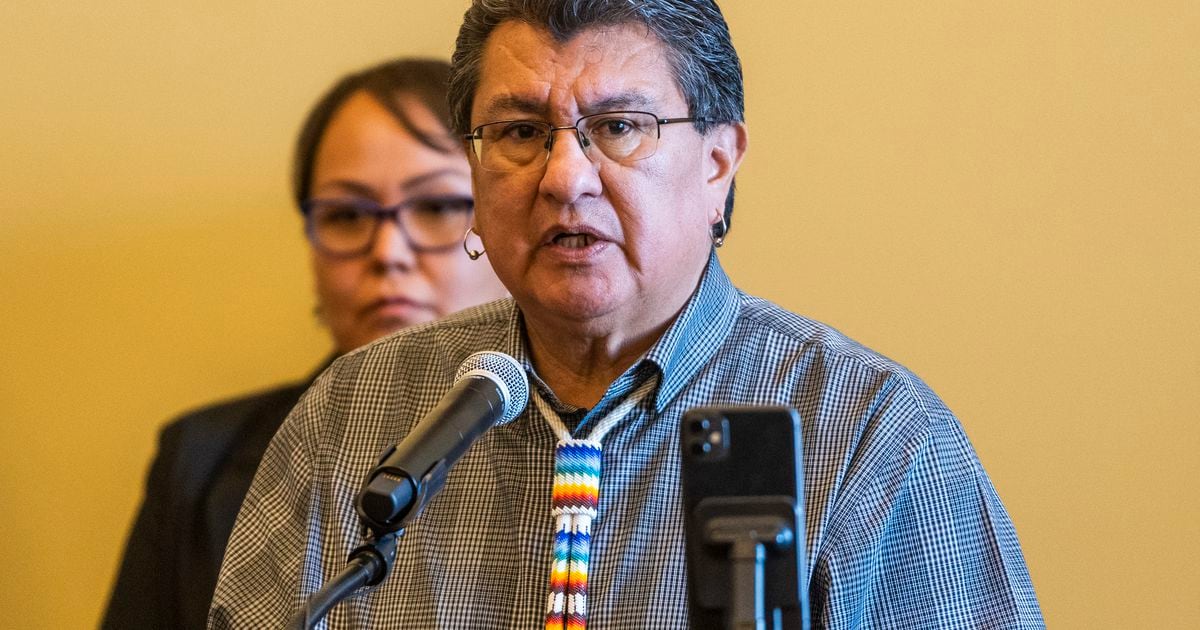Alaska
Alaska leaders, tribal groups react to ruling to uphold Indian Child Welfare Act
/cloudfront-us-east-1.images.arcpublishing.com/gray/FOCE46IBTBBCZD2ORBIXB7GPQ4.jpeg)
ANCHORAGE, Alaska (KTUU) – In a 7-2 decision, the United States Supreme Court voted to uphold the Indian Child Welfare Act, which gives preference to Native American families in foster care when adopting Native children.
The two dissenters were Justices Clarence Thomas and Samuel Alito.
Many were concerned that the court would weaken or strike the law, which plays an important role in maintaining tribal identity for adoptees.
Enacted in 1978, the Indian Child Welfare Act provides guidelines for the placement of American Indian and Alaska Native foster children in custody, foster care, and adoption cases. It came as a response to the high number of Native American children being placed with non-Native families. The Supreme Court took up the case after three white families and several states challenged the law, claiming that it is based on race and therefore unconstitutional under the equal protection clause.
Thursday’s ruling reaffirmed the federal law and will prioritize placement of Native children with Native families in order grow up with their tradition and cultural practices. Under ICWA, a child’s own family would be the first choice for placement, followed by a family from the same tribe or nation. If no one from the child’s family or tribe are in consideration, a Native family of a different tribal affiliation would be the next preferred placement.
The decision is especially important in Alaska, home to 229 federally-recognized tribes and hundreds of Alaska Native entities. Reports show thousands of Alaska Native children involved in the child welfare system every year.
Nicole Borromeo, the executive vice president and general counsel for the Alaska Federation of Natives went as far as calling this decision “earth shattering.”
“The Brackeen decision had an enormous impact on Alaska. we’re home to over 40 percent of the nations tribes — 229 — and ICWA is a foundational cornerstone in which we’ve set many different federal policies on,” Borromeo said.
“The court really said it best — Native people have the right to raise their children in our cultures. Our tribes have the right to continue on as we have for millennium. And Congress have the right to legislate in the area of Indian affairs under its plenary power,” Borromeo said.
According to Borromeo, culture is the heartbeat of who Alaska Native people are, as most of their history is passed down orally. To Borromeo, it’s a significant decision that will ensure Alaska Native cultures and traditions survive with the next generation.
Many Alaska Natives, tribes, and organizations have been anxiously awaiting the Supreme Court’s decision — and now many are calling it a victory, including Alaska Native Justice Center chief operating officer Alex Cleghorn.
“Today’s decision by the U.S. Supreme Court is an overwhelming victory for tribal sovereignty, for tribes and for native children. We couldn’t have expected a better decision,” Cleghorn said.
“I think it is recognition, I think it’s respect, I think is a ringing endorsement for the findings of ICWA,” Cleghorn said.
Other leaders have come out in support of the Supreme Court’s decision on Thursday. Representative Mary Peltola reiterated the importance of the decision in a statement.
“This decision provides certainty and security for children and families all across this country, and respects the basic principles of self-governance for Native American tribes,” Peltola said. “This is an important step in continuing the process of intergenerational healing from long histories of separation and loss, and a victory for tribal advocates everywhere.”
Attorney General Treg Taylor also commented on the decision.
“Our commitment to partnership, communication and collaboration with Tribes in Alaska is steadfast. We understand and appreciate the value Tribes bring to child welfare in Alaska,” Taylor said.
Copyright 2023 KTUU. All rights reserved.

Alaska
Gardening Tips: Successfully cultivating red rhubarb in Alaska

FAIRBANKS, Alaska (KTVF) – Among the wide world of vegetables, a popular one to grow in the Alaskan Interior is rhubarb.
Glen Risse, Co-Owner of Risse Greenhouse, said, “Rhubarb is something we enjoy growing, and our customers can’t get enough of. We grow a variety called the Canadian Red, which gives you red stalks and makes your pies much prettier than the green stalks.”
These particular rhubarbs are grown using a technique called separation. “They develop plants underground, and we separate them and put them in pots, and over time, they develop much larger plants,” said Risse.
Separation can be done using a shovel, as long as some of the main stalk is in each half. “We’re going to cut this plant right in half. So, attached to the bottom of this plant are these big, long, brown, underground stems, and what you can do… if you just remove some of the larger leaves so the plant isn’t trying to support a bunch up top, this is a great start right here. You put that in the ground, and it will grow.”
While rhubarbs can be planted year round, spring is the best season to separate them.
Risse noted that the leaves on rhubarb are poisonous. “It also is a high consumer of a minor element called molybdenum, so if you can, what’s best is to take your leaves and tear them up and put them back around the base of your plants. This will ensure that you have the molybdenum you need for your plants to grow healthy.”
When picking rhubarb, Risse recommends going all the way down to the bottom of the stalk for a clean grab. “You don’t want to snap it off in the middle, because that will give you a place where the plant could rot.”
Seed pots, meanwhile, can be torn out from the bottom as well and reintroduced into the soil.
While the color of the rhubarb doesn’t affect its flavor, many prefer a red tint for aesthetic reasons when making rhubarb pie. “If your rhubarb isn’t as red as you like, you can take and get a little bit of some ash out of your wood stove and sprinkle it around the base of your plant. That potash will change the PH and your rhubarb will turn red,” Risse advised.
He added, however, that too much ash can kill the plant.
Risse recommends planting individual rhubarb plants about three feet apart, and cutting rhubarb about an inch away from the leaf.
Copyright 2024 KTVF. All rights reserved.
Alaska
Alaska implements limits on cruise ship passengers after record footfall
)
While many businesses benefit from tourist spending, residents are increasingly troubled by noisy helicopters, congested streets and trails, and environmental damage. To address these issues, Juneau has struck a deal with the Cruise Lines International Association in Alaska. The agreement sets daily limits of 16,000 passengers from Sundays to Fridays, and 12,000 on Saturdays
read more
Alaska’s capital city Juneau located on the Gastineau Channel, is taking action to manage the influx of cruise ship tourists, amid rising worries about the impact on local life.
This came also after city saw a record 1.65 million cruise passengers last year, marking a 23% increase from previous highs.
While many businesses benefit from tourist spending, residents are increasingly troubled by noisy helicopters, congested streets and trails, and environmental damage. To address these issues, Juneau has struck a deal with the Cruise Lines International Association in Alaska. The agreement sets daily limits of 16,000 passengers from Sundays to Fridays, and 12,000 on Saturdays.
Alexandra Pierce, Juneau’s tourism manager, highlighted city’s stance on managing growth within its current infrastructure limitations. She highlighted the importance of balancing economic benefits with residents’ concerns and preserving local livelihoods.
Despite this effort, longtime critic of the cruise industry, Karla Hart, remains skeptical. She fears that even with the agreed limits, the city could still see record-breaking arrivals during the 22-week cruise season. Hart is advocating for a local referendum proposing “ship-free Saturdays” to protect community quality of life.
The global cruise industry, rebounding strongly post-pandemic, continues to grow with increasingly large ships. For instance, the Icon of the Seas, launched in January, accommodates over 7,000 passengers and boasts the world’s largest onboard waterpark.
Juneau’s concerns echo those of other cities worldwide grappling with social and environmental impacts from cruise tourism. Venice has banned large cruise ships from its lagoon, while Barcelona and Amsterdam have implemented restrictions and taxes to mitigate these effects.
Hart highlighted ongoing concerns about emissions, ship strikes, and climate change attributed to cruise ship and urged further measures to safeguard Juneau’s environment and community well-being.
Alaska
YMCA of Alaska and Alyeska Ski Resort break down new development plans

The Supreme Court on Friday struck down a Trump-era ban on bump stocks, the rapid-fire gun accessory used in the 2017 Las Vegas mass shooting that killed 60 people — including the gunman — and wounded more than 400. Alaskans reacted to the ruling Friday, many expressing mixed reactions.
-

 News1 week ago
News1 week agoWoman handcuffed in police car hit by freight train reaches $8.5M settlement
-

 News1 week ago
News1 week agoIsrael used a U.S.-made bomb in a deadly U.N. school strike in Gaza
-

 World1 week ago
World1 week agoEconomy, migration: Voters' main concerns ahead of elections
-

 Politics1 week ago
Politics1 week agoTrump campaign accelerates vetting of potential running mates
-

 Movie Reviews1 week ago
Movie Reviews1 week agoShort Film Review: Blue and White (2022) by Hiroyuki Nishiyama
-

 World1 week ago
World1 week agoWorld leaders, veterans mark D-Day’s 80th anniversary in France
-

 World1 week ago
World1 week agoFrance to provide Ukraine with its Mirage combat aircraft
-

 World1 week ago
World1 week agoRussia-Ukraine war: List of key events, day 833



















